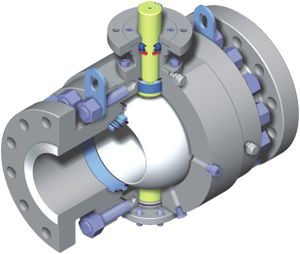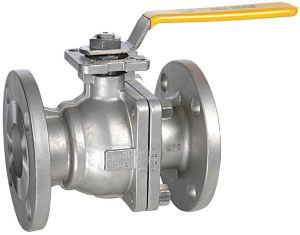Ball Valves
Ball Valve is a valve with a spherical disc, the part of the valve which controls the flow through it. The sphere has a hole, or port, through the middle so that when the port is in line with both ends of the valve, flow will occur. When the valve is closed, the hole is perpendicular to the ends of the valve, and flow is blocked. The handle or lever will be inline with the port position letting you see the valve's position. The ball valve, along with the butterfly valve and plug valve, are part of the family of quarter turn valves.
Ball valves are durable and usually work to achieve perfect shutoff even after years of disuse. They are therefore an excellent choice for shutoff applications . They do not offer the fine control that may be necessary in throttling applications but are sometimes used for this purpose. Ball valves are used extensively in industrial applications because they are very versatile, supporting pressures up to 1000 bar and temperatures up to 482°F (250°C). Sizes typically range from 0.2 to 11.81 inches (0.5 cm to 30 cm). They are easy to repair and operate.
The body of ball valves may be made of metal, plastic or metal with a ceramic center. The ball is often chrome plated to make it more durable. A ball-check valve is a type of check valve with a ball without a hole for a disc, and is not covered in this article.
Types of ball valve
There are five general body styles of ball valves: single body, three piece body, split body, top entry, and welded. The difference is based on how the pieces of the valve especially the casing that contains the ball itself—are manufactured and assembled. The valve operation is the same in each case.
In addition, there are different styles related to the bore of the ball mechanism itself:
- A full port or more commonly known full bore ball valve has an over-sized ball so that the hole in the ball is the same size as the pipeline resulting in lower friction loss. Flow is unrestricted but the valve is larger and more expensive so this is only used where free flow is required, for example in pipelines which require pigging.
- In reduced port or more commonly known reduced bore ball valves, flow through the valve is one pipe size smaller than the valve's pipe size resulting in flow area being smaller than pipe.
- A V port ball valve has either a 'v' shaped ball or a 'v' shaped seat. This allows the orifice to be opened and closed in a more controlled manner with a closer to linear flow characteristic. When the valve is in the closed position and opening is commenced the small end of the 'v' is opened first allowing stable flow control during this stage. This type of design requires a generally more robust construction due to higher velocities of the fluids, which might damage a standard valve. These can be referred to as a type of control valve but are not as accurate as a pressure regulator.
- A Kompact ball valve is a full port valve that fits between 2 flanges. Due to its configuration, its body is slimmer however and less metal.
- Cavity filler Ball Valve. Many industries encounter problem with residues in the ball valve. Where the fluid is meant for human consumption, residues may also be health hazard, and when where the fluid changes from time to time contamination of one fluid with another may occur. Residues arise because in the half open position of the ball valve a gap is created between the ball bore and the body in which fluid can be trapped. To avoid the fluid getting into this cavity, the cavity has to be plugged, which can be done by extending the seats in such a manner that it is always in contact with the ball. This type of ball valve is known as Cavity Filler Ball Valve.
There are a few types of ball valves related to the attachment and lateral movement of the ball:
- A trunnion ball valve has additional mechanical anchoring of the ball at the top and the bottom, suitable for larger and higher pressure valves .
- A floating ball valve is one where the ball is not held in place by a trunnion. In normal operation, this will cause the ball to float downstream slightly. This causes the seating mechanism to compress under the ball pressing against it. Furthermore, in some types, in the event of some force causing the seat mechanism to dissipate , the ball will float all the way to metal body which is designed to seal against the ball providing a somewhat failsafe design.
Manually operated ball valves can be closed quickly and thus there is a danger of water hammer. Some ball valves are equipped with Actuators that may be pneumatically or motor operated. These Valves can be used either for on or off or flow control. A pneumatic flow control valve is also equipped with a positioner which transforms the control signal into actuator position and valve opening accordingly.

